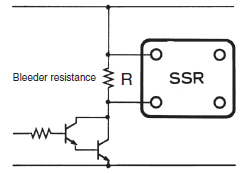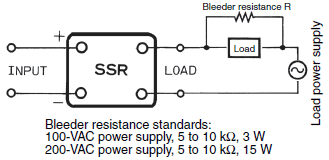The Solid-state Relay does not turn OFF. What is causing this and what can be done about it?
There may be separate causes for the input side and the output side. The following provides separate explanations.
Input Side:
1. Leakage current of the drive circuit on the input side may be causing a reset failure. Insert a bleeder resistor as a countermeasure.
Connect a bleeder resistor as in the figure above and set the bleeder resistance value so that the Solid-state Relay input voltage is 0.5 V max. when the Solid-state Relay is OFF.
2. Inductive noise may be inducing voltage on the input circuit. As a countermeasure, separate the power lines and the signal lines. Also use twisted wire or shielded wire to reduce the inductive voltage to below the Solid-state Relay reset voltage.
Output Side:
1. Reset Failure due to Solid-state Relay Leakage Current
Reset Failure due to Solid-state Relay Leakage Current Even when there is no input signal to the Solid-state Relay there is a small Leakage Current (IL) from the Solid-state Relay output (LOAD). If this Leakage Current is larger than the load release current, the Solid-state Relay may fail to reset.
Connect the bleeder resistance R in parallel to increase the Solid-state Relay switching current.

E: Load (relays etc.) reset voltage
I: Load (relays etc.) reset current
IL: Leakage current from the Solid-state Relay
Note: Microloads can be supported by using a bleeder resistor as described above. MOS FETs, however, can be used to directly switch microloads without a bleeder resistor.
2. Reset Failure Using Load with Low Power Factor
If the power factor of the load is low (guideline: cosΦ=0.4 max.), the delay in the load current phase will increase relative to the load power supply voltage phase, and a large transient voltage (dv/dt) will be applied to the Solid-state Relay when it is about to turn OFF (i.e., the load current is near zero), resulting in the possibility of the Solid-state Relay not being able to turn OFF (commutation failure).
The Solid-state Relay has a built-in CR snubber circuit to limit the rate of change in the transient voltage, but leakage current will increase if the C value is increased, and reset failure in item 1 above may occur, so the C value is set to the greatest common factor.
Therefore, if reset failure occurs because the load power factor is low, the rate of change in the transient voltage can be limited to prevent reset failure by connecting a capacitor and resistor in parallel with the Solid-state Relay load terminals.
The capacitor and resistor must be checked to match the load, but previous experience shows that a resistor of 100 Ω/1 W and a capacitor of 0.1 μF/250 VAC will prevent reset failure.
Also, as mentioned above, the leakage current will increase, so check that the reset failure in item 1 does not occur.